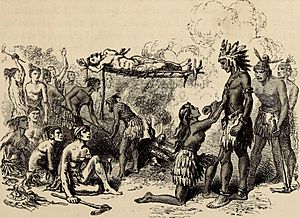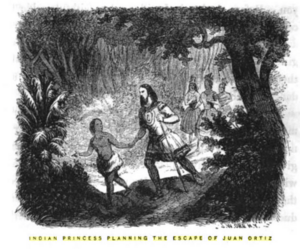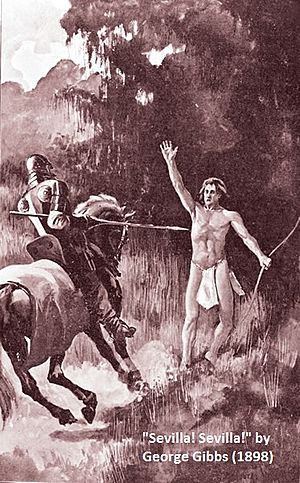Juan Ortiz (captive) facts for kids
Juan Ortiz was a Spanish sailor who was held captive by Native Americans in Florida for eleven years. This happened from 1528 until he was rescued by the Hernando de Soto expedition in 1539. Different stories tell how Ortiz was sentenced to death by a Native American chief two or three times. Each time, he was saved by the chief's daughter (and possibly other female relatives). He finally escaped to a nearby chiefdom, where the chief protected him.
Contents
Juan Ortiz: A Spanish Sailor's Story
Captured in Florida
In 1528, Juan Ortiz was on a ship looking for signs of the Narváez expedition in Tampa Bay. That expedition had landed there the year before. Ortiz and some friends were tricked into going ashore by people who seemed to have a message from Narváez. (The Spanish would not find out what happened to the Narváez expedition for eight more years.)
Ortiz and his friends were captured by the people on shore. Their shipmates left them behind. Everyone but Ortiz was killed either while fighting capture or soon after being taken to the town of Uzita.
After Ortiz was brought to Uzita, the chief ordered him tied to a rack over a fire. The chief's daughter begged her father to spare Ortiz's life. She argued that Ortiz was not a danger to him.
Saved by a Chief's Daughter
After Ortiz's burns were treated, he was given a job. He had to guard bodies placed in the town's charnel house (a building where bones or bodies are stored). His job was to keep animals from taking the bodies at night.
One night, a wolf took the body of a young child who had recently died. Ortiz chased the wolf in the dark and killed it. He got the child's body back. After this, Chief Uzita treated Ortiz better for a while.
Escaping to a New Home
Two or three years after Ortiz was captured, the chiefdom of Mocoso attacked Uzita. They burned the town. The town of Uzita then moved to a new place. The chiefdom's gods demanded that Ortiz be sacrificed.
The daughter of Chief Uzita warned Ortiz that he was going to be sacrificed. She told him he should go to Mocoso. The chief of Mocoso had asked for Ortiz to be given to him. The daughter led Ortiz out of the town at night. She showed him the path to Mocoso.
Found by De Soto
Juan Ortiz was found by the de Soto Expedition when they landed in Tampa Bay in 1539. After first landing at Uzita, de Soto and his men heard about a Christian living in a nearby chiefdom.
While looking for Ortiz, de Soto's men met about ten Native Americans. They started to attack them. Ortiz was with the group being attacked. But he managed to make the Spanish understand he was a Christian. One story says he shouted "Sevilla," which was his hometown.
Ortiz then led the Spanish to the town of Mocoso. The chief there, also named Mocoso, had protected him for many years. Chief Mocoso was friendly to de Soto. This caused problems between Mocoso and other chiefdoms around Tampa Bay, like Orriygua, Neguarete, Capaloey, and Uzita.
A Key Translator
Ortiz could speak the languages of both Uzita and Mocoso. These languages were very different from each other. The language of Mocoso was a type of Timucua language. This made Ortiz very helpful to de Soto.
As the expedition traveled up the Florida peninsula, they went through areas that spoke different types of the Timucua language. When the expedition crossed the Aucilla River, they entered the Apalachee Province. From that point, the expedition used Timucua speakers who could translate from other languages. Ortiz then translated from Timucua into Spanish.
Juan Ortiz died sometime during the winter of 1541–1542. This happened while the expedition was camped at the town of Autiamque in what is now Arkansas.
The Legend Grows
The story of Juan Ortiz and the daughter of Chief Hirrihigua has become a legend. In some versions, the chief's daughter is called "Princess Hirrihigua." She even has a name, "Uleleh."
The Princess Hirrihigua Chapter of the Daughters of the American Revolution put up a marker in St. Petersburg, Florida, in 1960. It remembers the story of Juan Ortiz and Princess Hirrihigua. A longer version of this legend, with the name "Uleleh," was published in 1908. It was called "The Story of Juan Ortiz and Uleleh."
A Similar Story?
Some experts believe that John Smith's story of being saved by Pocahontas might have been inspired by Juan Ortiz's story. Smith said he was saved from death by Powhatan's daughter, Pocahontas.
Richard Hakluyt's English translation of a book about the de Soto expedition was published in London in 1609. This was several years before John Smith published his account of being saved by Pocahontas.
See also
 In Spanish: Juan Ortiz (cautivo) para niños
In Spanish: Juan Ortiz (cautivo) para niños




